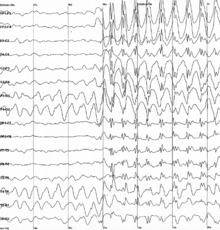User:Mr. Ibrahem/Epileptic seizure
| Epileptic seizure | |
|---|---|
| Other names | Epileptic fit,[1] seizure, fit, convulsions[2] |
 | |
| Generalized 3 Hz spike and wave discharges in EEG | |
| Specialty | Neurology, emergency medicine |
| Symptoms | Variable[3] |
| Duration | Typically < 2 minutes[4] |
| Types | Provoked, unprovoked[5] |
| Causes | Provoked: Low blood sugar, alcohol withdrawal, low blood sodium, fever, brain infection, concussion[3][5] Unprovoked: Unknown, brain injury, brain tumor, previous stroke[4][3][5][6] |
| Diagnostic method | Based on symptoms, blood tests, medical imaging, electroencephalography[6] |
| Differential diagnosis | Syncope, nonepileptic psychogenic event, tremor, migraine, transient ischemic attack[3][4] |
| Treatment | Less than 5 min: Place person on their side, remove nearby dangerous objects[7] More than 5 min: Treat as per status epilepticus[7] |
| Frequency | ~10% of people (at one point in time)[4][8] |
A seizure, formally known as an epileptic seizure, is a period of symptoms due to abnormally excessive or synchronous neuronal activity in the brain.[5] Outward effects vary from uncontrolled shaking movements involving much of the body with loss of consciousness (tonic-clonic seizure), to shaking movements involving only part of the body with variable levels of consciousness (focal seizure), to a subtle momentary loss of awareness (absence seizure).[3] Most of the time these episodes last less than 2 minutes and it takes some time to return to normal.[4][7] Loss of bladder control may occur.[3]
Seizures may be provoked and unprovoked.[5] Provoked seizures are due to a temporary event such as low blood sugar, alcohol withdrawal, low blood sodium, fever, brain infection, or concussion.[3][5] Unprovoked seizures occur without a known or fixable cause such that ongoing seizures are likely.[4][3][5][6] Unprovoked seizures may be triggered by stress or sleep deprivation.[3] Diseases of the brain, where there has been at least one seizure and a long term risk of further seizures, are collectively known as epilepsy.[5] Conditions that look like epileptic seizures but are not include: fainting, nonepileptic psychogenic event and tremor.[3]
A seizure that lasts for more than a brief period is a medical emergency.[9] Any seizure lasting longer than 5 minutes should be treated as status epilepticus.[7] A first seizure generally does not require long-term treatment with anti-seizure medications unless a specific problem is found on electroencephalogram (EEG) or brain imaging.[6] Typically it is safe to complete the work-up following a single seizure as an outpatient.[3] In many, with what appears to be a first seizure, other minor seizures have previously occurred.[10]
Up to 10% of people have at least one epileptic seizure.[4][8] Provoked seizures occur in about 3.5 per 10,000 people a year while unprovoked seizures occur in about 4.2 per 10,000 people a year.[4] After one seizure, the chance of experiencing a second is about 50%.[11] Epilepsy affects about 1% of the population at any given time[8] with about 4% of the population affected at some point in time.[6] Nearly 80% of those with epilepsy live in developing countries.[8] Many places require people to stop driving until they have not had a seizure for a specific period.[4]
References[edit]
- ^ Shorvon, Simon (2009). Epilepsy. OUP Oxford. p. 1. ISBN 9780199560042. Archived from the original on 1 August 2020. Retrieved 27 July 2020.
- ^ "Seizures - National Library of Medicine". PubMed Health. Archived from the original on 7 January 2017. Retrieved 16 October 2018.
- ^ a b c d e f g h i j k Misulis, Karl E.; Murray, E. Lee (2017). Essentials of Hospital Neurology. Oxford University Press. p. Chapter 19. ISBN 9780190259433. Archived from the original on 1 August 2020. Retrieved 27 July 2020.
- ^ a b c d e f g h i Ferri, Fred F. (2018). Ferri's Clinical Advisor 2019 E-Book: 5 Books in 1. Elsevier Health Sciences. p. 959. ISBN 9780323550765. Archived from the original on 1 August 2020. Retrieved 27 July 2020.
- ^ a b c d e f g h Fisher, RS; Acevedo, C; Arzimanoglou, A; Bogacz, A; Cross, JH; Elger, CE; Engel J, Jr; Forsgren, L; French, JA; Glynn, M; Hesdorffer, DC; Lee, BI; Mathern, GW; Moshé, SL; Perucca, E; Scheffer, IE; Tomson, T; Watanabe, M; Wiebe, S (April 2014). "ILAE official report: a practical clinical definition of epilepsy". Epilepsia. 55 (4): 475–82. doi:10.1111/epi.12550. PMID 24730690. Archived from the original on 31 July 2020. Retrieved 27 July 2020.
- ^ a b c d e Wilden, JA; Cohen-Gadol, AA (15 August 2012). "Evaluation of first nonfebrile seizures". American Family Physician. 86 (4): 334–40. PMID 22963022.
- ^ a b c d "The Epilepsies and Seizures: Hope Through Research". National Institute of Neurological Disorders and Stroke. Archived from the original on 16 October 2018. Retrieved 16 October 2018.
- ^ a b c d "Epilepsy". World Health Organization. 8 February 2018. Archived from the original on 18 October 2018. Retrieved 16 October 2018.
- ^ "What Is A Seizure Emergency". epilepsy.com. Archived from the original on 9 May 2018. Retrieved 2018-05-08.
- ^ Angus-Leppan H (2014). "First seizures in adults". BMJ. 348: g2470. doi:10.1136/bmj.g2470. PMID 24736280.
- ^ Berg, AT (2008). "Risk of recurrence after a first unprovoked seizure". Epilepsia. 49 Suppl 1: 13–8. doi:10.1111/j.1528-1167.2008.01444.x. PMID 18184149.
